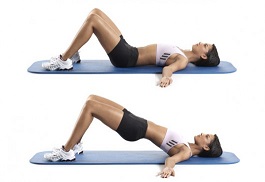You develop a hiatal hernia when a portion of your stomach forces out through your diaphragm. The diaphragm is between your chest and abdomen, and it is a large muscle that helps you breathe. The stomach is normally right below the diaphragm, but some part of it can push up through the diaphragm in people with hiatal hernia. You do not usually require any treatment for a hiatal hernia, but you may consider taking some drugs if you have some discomfort, and surgery is only necessary in rare cases. A better option is to practice hiatal hernia exercises which can help treat your condition and alleviate discomfort.
Exercises That Help Treat Hiatal Hernia
You can actually try a number of exercises to manage your condition, but you should talk to your doctor if you experience any pain or discomfort after trying a specific hiatal hernia exercise. Here are some effective exercises to consider.
1. The Warm Water Fix

- Drink a glass of warm water soon after waking up. Doing this will relax and put some weights for your stomach.
- Then, stand up and lift your arms to your sides. Now, bend your elbows in a way that your hands touch your chest. This will stress the diaphragm.
- Next, rise up on your toes and lift your body as high as possible. Then, drop down right on to your heels and repeat the same several times. By doing this, you will be able to pull the stomach down.
- Then, open your mouth and take a few quick breaths with your arms up. Doing it for 15 seconds can help tighten the diaphragm and close the opening.
2. Self-Massage

You can target the upper portion of your abdomen through massage. This will help reduce the discomfort and other symptoms of hiatal hernia by strengthening your stomach muscles.
- Start with your back on the floor.
- Put your fingers below your breastbones, find your rib cage and exert some pressure downward.
- Keep massaging the area and move towards your belly button.
- Do the same for 5 minutes.
- Massage the area at least twice a day, preferably in the morning and evening.
3. Yoga
.jpg)
Certain yoga poses can help alleviate pain and discomfort.
- Stand in an upright position with your arms perpendicular to the floor, and keep your feet about a hip's width apart.
- Slowly raise your arms and take them straight above your head.
- Bend your body at a 45-degree angle while moving your chest close to your thighs. Do not let your arms bend, and keep them aligned with your back with palms facing the floor.
- Bend your knees slowly and press your weight toward the ground while looking forward. Stay in that position for a few seconds and continue to take deep breaths.
- Now, lower your tailbone toward the ground while pressing your shoulder blades to your back. Be sure to draw in your abdomen. Maintain this pose for about 30 seconds and take deep breaths.
- Return to the starting position slowly.
- Repeat the same for a few times.
4. Bridge Pose

Here is a good hiatal hernia exercise that can strengthen your stomach muscles.
- Start by lying flat on your back. Bend your knees and keep your feet on the floor.
- Slowly lift your buttocks and lower back off the floor while making sure your feet and shoulders are on the floor all the time.
- Hold the pose for a few seconds and then return to the starting position.
- Do it 10 times a day.
5. Rib Cage Press
.jpg)
You can try this hiatal hernia exercise to alleviate discomfort caused by your hernia.
- Place your hands right in the center of your rib cage.
- Inhale deeply and press your fingers firmly just under the breastbone.
- Push your fingers downward while exhaling forcefully. Be sure to bend your fingers forward a bit, but do not push fingers under the rib cage.
- Do the same several times, especially on an empty stomach.
6. Breathing Exercise

Learning correct breathing technique will help you a lot with your hiatal hernia. Before you go any further, you first need to identify your current breathing pattern. You can do it by putting your hand on your tummy and noticing the movement of your abdomen. You are doing it right if your abdomen expands and contracts more than your chest while breathing.
If that is not the case, you need to learn how to return to abdominal breathing, and learn to relax your diaphragm to help your stomach move downward. To do this, you can use blue vervain in liquid form and practice breathing: exhaling as much air as possible before inhaling. Practice breathing as often as you can.
7. Ileocecal Valve Massage
.jpg)
The ileocecal valve is located on the right side of your tummy about midway between the right hipbone and the belly button. Massaging this area will help reduce discomfort caused by hiatal hernia. Just be sure to breathe deeply while massaging. Do it at least once a day.
When to Call a Doctor
You should call your doctor immediately if you have a hiatal hernia and are experiencing symptoms such as nausea and abdominal pain with an inability to pass gas or have a bowel movement. These symptoms indicate that you have strangulated hernia which requires immediate medical attention.
